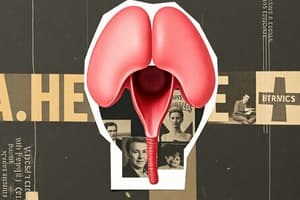Podcast
Questions and Answers
Where is the pituitary gland located?
Where is the pituitary gland located?
At the base of the brain in the Sella turcica within the sphenoid bone.
What type of connection does the posterior pituitary have with the hypothalamus?
What type of connection does the posterior pituitary have with the hypothalamus?
- No connection
- Neural (correct)
- Hormonal
- Vascular
Which of the following hormones is released from the anterior pituitary?
Which of the following hormones is released from the anterior pituitary?
- Antidiuretic hormone (ADH)
- Oxytocin
- Somatomedin
- Luteinizing hormone (LH) (correct)
What type of cells in the anterior pituitary secrete growth hormone?
What type of cells in the anterior pituitary secrete growth hormone?
The secretion of antidiuretic hormone (ADH) is controlled by the anterior pituitary.
The secretion of antidiuretic hormone (ADH) is controlled by the anterior pituitary.
The main hormone responsible for the promotion of growth is __________.
The main hormone responsible for the promotion of growth is __________.
Which hypothalamic hormone stimulates the release of thyroid-stimulating hormone (TSH)?
Which hypothalamic hormone stimulates the release of thyroid-stimulating hormone (TSH)?
What effect does growth hormone (GH) have on proteins?
What effect does growth hormone (GH) have on proteins?
Match the following anterior pituitary hormones with their functions.
Match the following anterior pituitary hormones with their functions.
Flashcards are hidden until you start studying
Study Notes
Overview of the Pituitary Gland
- Located at the base of the brain within the Sella turcica of the sphenoid bone.
- Connected to the hypothalamus via the pituitary stalk.
- Known as "The Master Gland" due to its regulation of other endocrine glands.
- Secretion is controlled by the hypothalamus.
Lobes of the Pituitary Gland
- Posterior Pituitary (Neurohypophysis)
- Neural connection with the hypothalamus.
- Embryological origin from the third ventricle of the brain.
- Anterior Pituitary (Adenohypophysis)
- Vascular connection with the hypothalamus.
- Derived from the oral cavity's invagination (Rathke’s pouch).
Hormones Secreted by the Pituitary Gland
-
Posterior Pituitary Hormones
- Oxytocin: involved in childbirth and lactation.
- ADH (Antidiuretic Hormone): regulates water balance in the body.
- Neurophysin: a prohormone released alongside oxytocin or ADH.
-
Anterior Pituitary Hormones
- Basophils
- TSH (Thyroid-stimulating hormone)
- ACTH (Adrenocorticotropic hormone)
- FSH (Follicle-stimulating hormone)
- LH (Luteinizing hormone)
- Acidophils
- GH (Growth hormone): promotes growth.
- PRL (Prolactin): stimulates milk production.
- Basophils
Cell Types in the Anterior Pituitary
- Somatotropes: Secrete growth hormone; constitute about 50% of anterior pituitary cells.
- Corticotropes: Produce adrenocorticotropin (ACTH).
- Thyrotropes: Secrete thyroid-stimulating hormone (TSH).
- Lactotropes: Produce prolactin (PRL).
- Gonadotropes: Synthesize gonadotropic hormones (LH and FSH).
Hypothalamus Functions
- Integrates endocrine and nervous system activities.
- Secretes releasing and inhibitory hormones that regulate anterior pituitary secretion.
- Sends nerve signals to control posterior pituitary hormone release.
- Utilizes hypothalamic-hypophysial portal vessels for hormone transport to anterior pituitary.
Hypothalamic Hormones and Their Effects
- TRH (Thyrotropin Releasing Hormone): Stimulates TSH release.
- CRH (Corticotropin Releasing Hormone): Induces ACTH release.
- GnRH (Gonadotropin Releasing Hormone): Promotes LH and FSH release.
- GHRH (Growth Hormone Releasing Hormone): Stimulates GH release.
- GHIH (Growth Hormone Inhibitory Hormone, Somatostatin): Inhibits GH release.
- Dopamine (Prolactin-inhibiting hormone): Inhibits prolactin release.
Actions of Growth Hormone (GH)
- Promotes growth by increasing cell size and number.
- Enhances protein synthesis and maintains positive nitrogen balance.
- Increases mobilization of fatty acids; affects carbohydrate metabolism, leading to insulin resistance.
- Stimulates cartilage proliferation at growth plates, facilitating linear growth.
- Encourages secretion of insulin-like growth factor-1 (IGF-1) from the liver, which mediates GH effects.
Somatomedins
- GH influences growth indirectly through somatomedins, primarily IGF-1.
- IGF-1 secretion is independent of GH before birth but is stimulated by GH afterward.
Studying That Suits You
Use AI to generate personalized quizzes and flashcards to suit your learning preferences.




